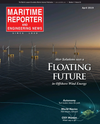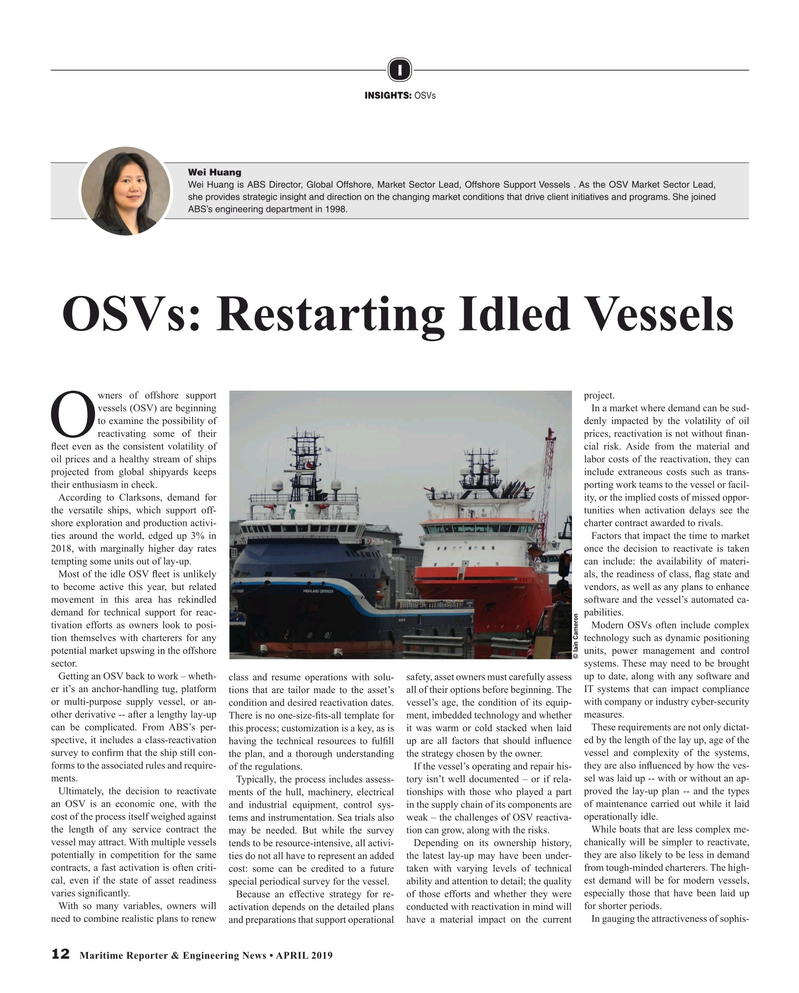
Page 12: of Maritime Reporter Magazine (April 2019)
Navies of the World
Read this page in Pdf, Flash or Html5 edition of April 2019 Maritime Reporter Magazine
I
INSIGHTS: OSVs
Wei Huang
Wei Huang is ABS Director, Global Offshore, Market Sector Lead, Offshore Support Vessels . As the OSV Market Sector Lead, she provides strategic insight and direction on the changing market conditions that drive client initiatives and programs. She joined
ABS’s engineering department in 1998.
OSVs: Restarting Idled Vessels wners of offshore support project.
vessels (OSV) are beginning In a market where demand can be sud- to examine the possibility of denly impacted by the volatility of oil
Oreactivating some of their prices, reactivation is not without ? nan- ? eet even as the consistent volatility of cial risk. Aside from the material and oil prices and a healthy stream of ships labor costs of the reactivation, they can projected from global shipyards keeps include extraneous costs such as trans- their enthusiasm in check. porting work teams to the vessel or facil-
According to Clarksons, demand for ity, or the implied costs of missed oppor- the versatile ships, which support off- tunities when activation delays see the shore exploration and production activi- charter contract awarded to rivals.
ties around the world, edged up 3% in Factors that impact the time to market 2018, with marginally higher day rates once the decision to reactivate is taken tempting some units out of lay-up. can include: the availability of materi-
Most of the idle OSV ? eet is unlikely als, the readiness of class, ? ag state and to become active this year, but related vendors, as well as any plans to enhance movement in this area has rekindled software and the vessel’s automated ca- demand for technical support for reac- pabilities.
tivation efforts as owners look to posi- Modern OSVs often include complex tion themselves with charterers for any technology such as dynamic positioning potential market upswing in the offshore units, power management and control © Iain Cameron sector. systems. These may need to be brought
Getting an OSV back to work – wheth- class and resume operations with solu- safety, asset owners must carefully assess up to date, along with any software and er it’s an anchor-handling tug, platform tions that are tailor made to the asset’s all of their options before beginning. The IT systems that can impact compliance or multi-purpose supply vessel, or an- condition and desired reactivation dates. vessel’s age, the condition of its equip- with company or industry cyber-security other derivative -- after a lengthy lay-up There is no one-size-? ts-all template for ment, imbedded technology and whether measures.
can be complicated. From ABS’s per- this process; customization is a key, as is it was warm or cold stacked when laid These requirements are not only dictat- spective, it includes a class-reactivation having the technical resources to ful? ll up are all factors that should in? uence ed by the length of the lay up, age of the survey to con? rm that the ship still con- the plan, and a thorough understanding the strategy chosen by the owner. vessel and complexity of the systems, forms to the associated rules and require- of the regulations. If the vessel’s operating and repair his- they are also in? uenced by how the ves- ments. Typically, the process includes assess- tory isn’t well documented – or if rela- sel was laid up -- with or without an ap-
Ultimately, the decision to reactivate ments of the hull, machinery, electrical tionships with those who played a part proved the lay-up plan -- and the types an OSV is an economic one, with the and industrial equipment, control sys- in the supply chain of its components are of maintenance carried out while it laid cost of the process itself weighed against tems and instrumentation. Sea trials also weak – the challenges of OSV reactiva- operationally idle.
the length of any service contract the may be needed. But while the survey tion can grow, along with the risks. While boats that are less complex me- vessel may attract. With multiple vessels tends to be resource-intensive, all activi- Depending on its ownership history, chanically will be simpler to reactivate, potentially in competition for the same ties do not all have to represent an added the latest lay-up may have been under- they are also likely to be less in demand contracts, a fast activation is often criti- cost: some can be credited to a future taken with varying levels of technical from tough-minded charterers. The high- cal, even if the state of asset readiness special periodical survey for the vessel. ability and attention to detail; the quality est demand will be for modern vessels, varies signi? cantly. Because an effective strategy for re- of those efforts and whether they were especially those that have been laid up
With so many variables, owners will activation depends on the detailed plans conducted with reactivation in mind will for shorter periods.
need to combine realistic plans to renew and preparations that support operational have a material impact on the current In gauging the attractiveness of sophis- 12 Maritime Reporter & Engineering News • APRIL 2019
MR #4 (10-17).indd 12 4/2/2019 11:25:35 AM

 11
11

 13
13
